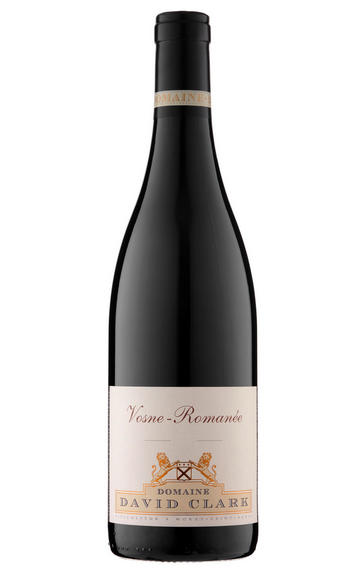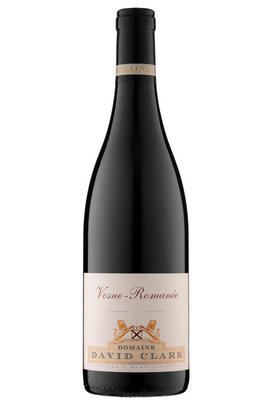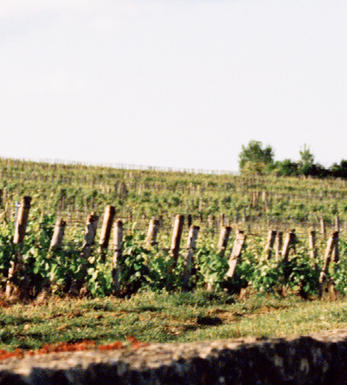
2010 Vosne-Romanée, Domaine David Clark, Burgundy

Critics reviews
Antonio Galloni - 29/02/2012
About this WINE

Domaine David Clark
After 10 successful years as a vigneron, David has decided to search out new challenges in his life. The 2012 vintage (available January 2014) is the last from this excellent source of Burgundy wine.
Domaine David Clark was based in the small village of Morey-Saint-Denis, nestled in the heart of Burgundy's famous and exclusive Côte de Nuits.
His penchant for wine, developed after spending a year working for a UK wine merchant, led him to the 1997 harvest at Mayacamas in the Napa Valley and the 1998 at Tahbilk in Australia. It was also within this region that he was interviewed and subsequently hired by the Williams Formula One team for the Grand Prix.
On leaving Williams in 2003, David Clark worked on an organic farm in the Auvergne to sharpen up on his French before attending the Lycée Viticole in Beaune. Having caught sight of an ad for a small (2/3 acre) vineyard of lowly generic Bourgogne appellation in 2004, Clark impulsively snapped it up. The open-plan style of the shared allotments enabled him to receive news of a house in Morey that had come on to the market with outbuildings for a cellar and storage. David Clark made a hand-crafted Bourgogne Rouge and an outstanding Bourgogne Passetoutgrains, a blend of Pinot Noir and some superior Gamay grapes from a vineyard facing the fabled Clos de Vougeot. He added a barrel of Morey-St-Denis in 2006, Côte de Nuits-Villages in 2007 and Vosne-Romanée from 2008. David proved exceptionally meticulous in the vineyard, working with grand cru level yields even in his generic vineyards.
Jasper Morris MW, Burgundy Wine Director and author of the award-winning Inside Burgundy comprehensive handbook.

Vosne-Romanée
The small commune of Vosne-Romanée is the Côte de Nuits’ brightest star, producing the finest and most expensive Pinot Noir wines in the world.. Its wines have an extraordinary intensity of fruit which manages to combine power and finesse more magically than in any other part of the Côte d’Or. The best examples balance extraordinary depth and richness with elegance and breeding.
Situated just north of Nuits-St Georges, Vosne-Romanée boasts eight Grand Cru vineyards, three of which include the suffix Romanée, to which the village of Vosne appended its name in 1866. The famous La Romanée vineyard was formerly known as Le Cloux but was renamed in 1651, presumably after the Roman remains found nearby. In 1760 the property was bought by Prince de Conti, and subsequently became known as Romanée-Conti.Vosne is the home of the phenomenally fine wines of Domaine de la Romanée-Conti; divine wines that are, as they say, not for everyone but for those who can afford them. The region also boasts some of the world’s most talented, quality-conscious and pioneering producers: Domaine de la Romanée-Conti of course, but also Henri Jayer, Lalou Bize-Leroy, René Engel, as well as the Grivot and Gros families, to name but a few.
Vosne-Romanée has the greatest concentration of top vineyards in the Côte d’Or, including the tiny Grand Crus of the astonishing La Romanée-Conti (a monopoly of Domaine de la Romanée-Conti producing about 600 cases a year), the classy, complex La Romanée (a monopoly of Vicomte Liger-Belair, but until 2002 bottled under Bouchard Père et Fils, producing a minuscule 300 cases or so a year) and the little-known La Grande Rue. As the name suggests, this runs up the side of the road out of Vosne. Originally a Premier Cru, it was rightly upgraded in 1992, although its rich, spicy, floral Pinots are yet to reach their real potential under Domaine Lamarche who hold it as a monopoly.
By convention the wines of neighbouring Flagey-Echézeaux are considered part of Vosne-Romanée. These include the large, very variable 30-hectare Echézeaux (divided between 84 different growers) and the more consistent, silky, intense, violet-scented Grands Echézeaux Grands Crus.
La Tâche is another monopoly of Domaine de la Romanée-Conti. It is explosively seductive with a peerless finesse, and is almost as good as their legendary eponymous wine. Richebourg is one of Burgundy’s most voluptuous wines and is capable of challenging La Tâche in some years, while Romanée-St Vivant, which takes its name from the monastery of St Vivant built around 900AD in Vergy, has a lovely silky finesse but is slightly less powerful.
If that wasn’t enough, Vosne-Romanée also boasts some absolutely magnificent Premiers Crus headed by Clos des Réas, Les Malconsorts (just south of La Tâche, and arguably of Grand Cru quality) and Les Chaumes on the Nuits-St Georges side, Cros Parantoux (made famous by Henri Jayer), Les Beaux Monts and Les Suchots on the Flagey-Echézeaux border. The old maxim that ‘there are no common wines in Vosne-Romanée’ may not be strictly true, but it is not far off.
Drinking dates vary, but as a general rule of thumb Grand Crus are best drunk from at least 10 to 25 years, while Premier Crus can be enjoyed from 8 to 20 years, and village wines from 5 to 12 years.
There are no white wines produced in Vosne-Romanée.
- 99 hectares of village Vosne-Romanée.
- 56 hectares of Premier Cru vineyards (14 in all). Foremost vineyards include Les Gaudichots, Les Malconsorts, Cros Parentoux, Les Suchots, Les Beauxmonts, En Orveaux and Les Reignots.
- 75 hectares of Grand Cru vineyards: Romanée-Conti, La Romanée, La Tache, Richebourg, Romanée St Vivant, La Grande Rue, Grands Echézeaux, Echézeaux.
- Recommended producers: Domaine de la Romanée Conti, Leroy, Cathiard, Engel, Rouget, Grivot, Liger Belair.

Pinot Noir
Pinot Noir is probably the most frustrating, and at times infuriating, wine grape in the world. However when it is successful, it can produce some of the most sublime wines known to man. This thin-skinned grape which grows in small, tight bunches performs well on well-drained, deepish limestone based subsoils as are found on Burgundy's Côte d'Or.
Pinot Noir is more susceptible than other varieties to over cropping - concentration and varietal character disappear rapidly if yields are excessive and yields as little as 25hl/ha are the norm for some climats of the Côte d`Or.
Because of the thinness of the skins, Pinot Noir wines are lighter in colour, body and tannins. However the best wines have grip, complexity and an intensity of fruit seldom found in wine from other grapes. Young Pinot Noir can smell almost sweet, redolent with freshly crushed raspberries, cherries and redcurrants. When mature, the best wines develop a sensuous, silky mouth feel with the fruit flavours deepening and gamey "sous-bois" nuances emerging.
The best examples are still found in Burgundy, although Pinot Noir`s key role in Champagne should not be forgotten. It is grown throughout the world with notable success in the Carneros and Russian River Valley districts of California, and the Martinborough and Central Otago regions of New Zealand.


Buying options
Add to wishlist
Description
The nose here is backward but suggests great intensity. Graceful fruit, bounds of energy, there is big heart to this wine, with excellent barrel integration and good acidity.
Jasper Morris MW, Burgundy Director
2010 has produced miniscule yields for David Clark, no more than 20 hl/ha, the most courageous Scotsman in Morey St-Denis. The wines are superb though, with very gentle extraction, no stems this year and of course, David’s meticulous attention to detail at his micro estate. This will be the last vintage for his Bourgogne Passetoutgrains, David having recently sold the vineyard.
wine at a glance
Delivery and quality guarantee